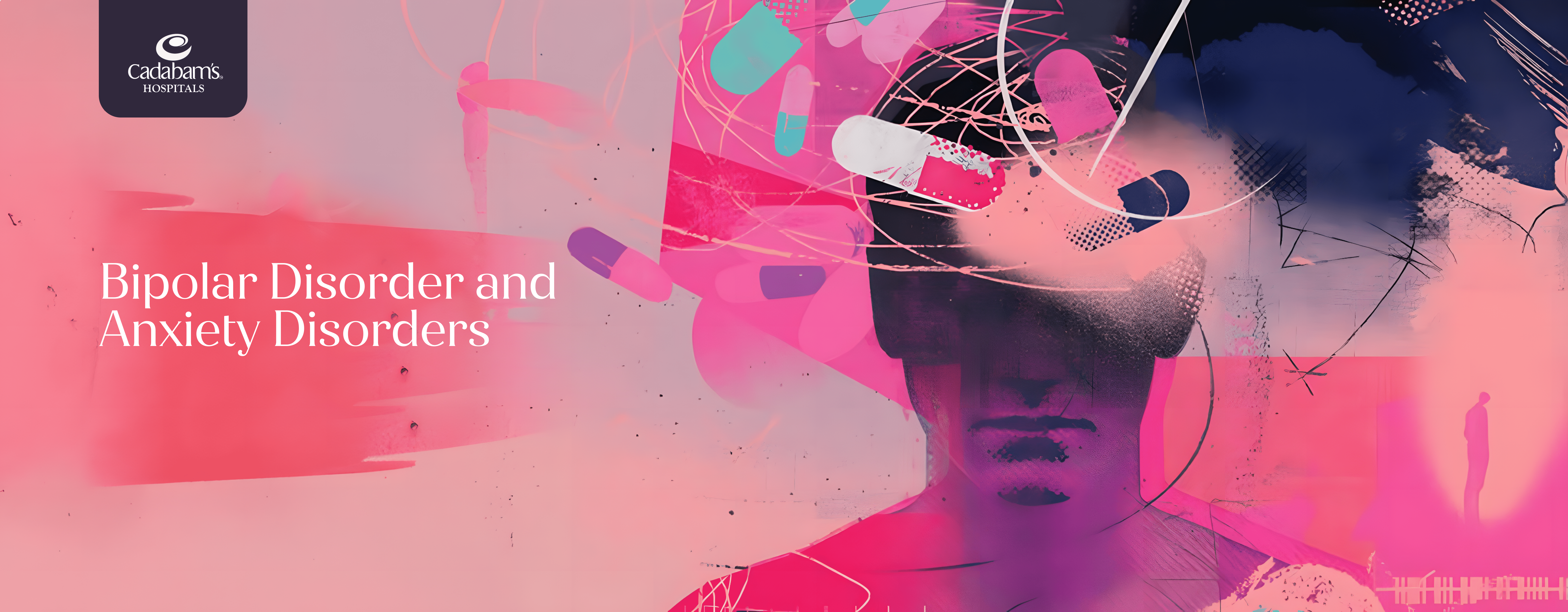Table of Content
Anxiety and bipolar are two distinct mental health conditions. Yet, they often intersect with many individuals experiencing symptoms of both at once. Bipolar disorder is usually characterized by extreme mood swings, and excessive fear or worry can be a part of it, which also happens to be one of the key manifestations of anxiety. Read on as we unfold this complex connection.
Difference Between Anxiety and Bipolar: How are these Two Conditions Connected?
Studies show that there is a significant connection between bipolar disorder and anxiety, and that individuals with bipolar often exhibit symptoms of anxiety at some point in their journey. Some common overlapping symptoms include restlessness, changes in sleep patterns and appetite, and feelings of sadness or hopelessness. Anxiety can be a component of bipolar disorder, particularly during depressive episodes, but it can also co-occur as a separate disorder. Living with both conditions simultaneously have shown to exacerbate symptoms among patients, leading to decreased quality of life.
The Overlap and Impact of Bipolar and Anxiety Disorders
With the overlap between bipolar and anxiety well-established, experts aim to conduct an accurate dual diagnosis focusing on identifying specifically intense symptoms to avoid complications in treatments. Some of the common overlapping factors include:
Exacerbation of Symptoms
It is often noted that the existence of anxiety during bipolar or vice-versa can exacerbate existing symptoms and affect the person’s ability to conduct daily activities.
- More frequent mood episodes – While facing frequent shifts in mood between manic and depressive episodes is common for people with bipolar, the presence of anxiety has shown to increase its likelihood.
- Higher occurrence of initial depressive episodes – People with anxiety often struggle with panic attacks, feelings of worry and shame and fear of failure. Coupled with bipolar, this has shown to possibly trigger increased depressive episodes.
- Increased episodes with mixed features – With increased co-existence, it is possible that a person faces depressive symptoms during manic phases and vice versa.
- Greater incidence of rapid cycling- Experts have noted anxiety can trigger stress responses that destabilize mood regulation in individuals with bipolar disorder, leading to rapid cycling.
Challenges in Treatment and Recovery
Overlap between bipolar and anxiety can cause various hindrances in treatment and recovery with its complex symptom interactions and thus, diagnostic ambiguity. While experts take an integrated approach to address both conditions concurrently, some challenges continue to affect treatment.
- Extended periods without treatment – Factors such as symptom variability and overlap may lead to misunderstandings in the nature and intensity of the conditions leading to prolonged periods without treatment. Further, diagnostic difficulties could prevent a person from getting timely treatment.
- Longer duration to achieve remission - The intricate interplay between mood and anxiety symptoms complicates therapeutic efficacy, necessitating careful medication selection and ongoing monitoring, leading to longer duration of treatment.
- Higher likelihood of suicidal ideation and attempts - The convergence of bipolar disorder and anxiety elevates the risk of suicidal ideation and attempts.
- Elevated risk of substance use disorder – The convergence of bipolar disorder and anxiety often leads to self-medication through substance use as people seek relief from their symptoms.
Consequences on Health and Well-being
Both bipolar and anxiety can affect a person’s ability to conduct everyday tasks, communicate with those around them and manage their health. An overlap of these conditions further exacerbates negative consequences for both the person and their caregivers.
- Negative outcomes from medication – Since diagnosis for co–existing anxiety and bipolar is challenging, patients may face paradoxical reactions, increased mood instability, or exacerbation of anxiety symptoms.
- Increased healthcare usage - The overlap of bipolar and anxiety disorders often necessitates increased healthcare usage due to the complexity of symptoms, frequent mood fluctuations, and heightened risk of comorbid conditions.
- Greater psychological distress - Individuals with overlapping bipolar and anxiety disorders experience greater psychological distress such as increased agitation, intrusive thoughts, and emotional dysregulation due to the synergistic effects of mood instability and anxiety symptoms.
- Reduced effectiveness of treatment - Due to complex symptom interactions, diagnostic challenges, and medication resistance, comorbid bipolar and anxiety may necessitate multiple interventions, increasing the likelihood of treatment non-response or relapse.
- Difficulty in maintaining treatment adherence – People with overlapping anxiety and bipolar may face fluctuating symptoms or even cognitive impairment over time, leading to difficulty in following through with treatment programs.
- Decline in overall functioning and quality of life
Symptoms of Co-occurring Anxiety and Bipolar Disorder
Individuals may experience persistent, intense feelings worry, panic attacks, anxiety spikes which can be seen across manic and depressive episodes. Another key symptom of this overlap can be seen in irregular sleep patterns in both manic and depressive phases, where a person stays up due to heightened anxiety. Another way to track this overlap is by keeping track of symptoms from a young age.
Risks of Bipolar and Anxiety Disorders
The co-occurrence of bipolar disorder and anxiety disorders presents several potential hazards including heightened severity of symptoms, increased susceptibility to suicidal thoughts and actions, elevated risk of substance use disorder, and amplified psychological distress. These risks are elevated as a result of complications in the diagnostic process, with patients not being able to detect it on time.
Treatment Approaches for Bipolar and Anxiety
Experts recommend a holistic approach to treating anxiety-bipolar co-occurrence and includes the following treatments.
Medication Strategies
Usually, patients with both bipolar and anxiety are prescribed a combination of different types of medications, including mood stabilizers and anti-depressants. Before prescribing, experts check the patient’s symptom profiles, potential interactions, and individual response patterns. With this information, they are usually given selective serotonin reuptake inhibitors (SSRIs) like fluoxetine. Depending on the nature and intensity of the symptoms, some experts also recommend benzodiazepines.
Psychotherapeutic Interventions
Therapy is a tried and tested method that aids in treating overlapping anxiety and bipolar disorder. It is often conducted alongside medication and other types of treatment. Some of the common therapeutic modalities include Cognitive Behavioral Therapy (CBT) aimed at changing behaviors over time, family therapy, group therapy among others. Mindfulness-based therapies have been beneficial in cultivating awareness and acceptance, promoting emotional regulation and stress management.
Additional Therapeutic Techniques
Additional therapeutic techniques usually refer to complimentary therapies which revolve around overall lifestyle and well-being rather than strictly focused on targeting the symptoms of the conditions themselves. These could include mood regulation practices, exercises or workout-based advice, relaxation techniques, or social support group-driven therapy.
Tips for Managing Bipolar and Anxiety Disorders
While bipolar and anxiety disorders are best treated under the guidance of trained experts, some tips can help with the management of these conditions, which can aid in the recovery process. Some include:
Engage with loved ones
As with many mental health conditions, supportive relationships offer understanding, encouragement, and practical assistance during periods of mania or depression. Sharing experiences with trusted individuals reduces feelings of isolation and strengthens coping mechanisms, while they play an active role in helping you recover.
Maintain regular physical activity
Exercise has several benefits to promote improved mental well-being with bipolar and anxiety. It helps improve mood, reduce anxiety, promotes better sleep and provides a better platform for anxiety management. In general, establishing a consistent exercise routine can contribute to overall wellness and enhance resilience.
Develop a consistent sleep schedule
Irregular sleep patterns are a common symptom of both anxiety and bipolar, and often trigger mood episodes while intensifying anxiety symptoms. Establishing a routine bedtime and wake-up time helps regulate circadian rhythms, promoting better sleep quality and stability.
Steer clear of alcohol and drugs
Using substances such as alcohol and drugs can worsen mood instability, increase anxiety levels, and interfere with medication effectiveness, making it a major hindrance for recovery from co-occurring bipolar and anxiety. It may also exacerbate symptoms and lead to substance use disorders, complicating treatment and recovery efforts.
Practice relaxation techniques
Incorporating practices like deep breathing, progressive muscle relaxation, and mindfulness meditation into daily routines can be immensely beneficial to tackle bipolar and anxiety disorders. These techniques serve to diminish stress, relieve symptoms of anxiety, and achieve emotional equilibrium.
Communicate regularly with your healthcare providers
Communicating regularly with your team of psychiatrists, psychologists, and therapists is key to making an effective recovery. Open dialogue allows for timely adjustments to treatment plans, ensuring they remain tailored to your evolving needs. They can offer support accordingly, monitor your progress, and address any concerns or challenges that arise.
Managing Bipolar Disorder and Anxiety Together with Cadabams
Bipolar disorder and anxiety are conditions with a history of often overlapping to create complications for the person. With diagnostic challenges and the need for personalized treatment, it is essential for a team of certified experts to manage this comorbid case.
If you are searching for a solution to your problem, Cadabam’s Hospitals can help you with its team of specialized experts. We have been helping thousands of people live healthier and happier lives for 30+ years. We leverage evidence-based approaches and holistic treatment methods to help individuals effectively manage their bipolar disorders. Get in touch with us today. You can call us at +91 97414 76476. You can even email us at info@cadabamshospitals.com.
FAQs
1. How do bipolar disorder and anxiety disorder affect each other?
Bipolar disorder and anxiety disorder can worsen each other's symptoms, leading to increased mood instability, rapid cycling, and heightened emotional distress, complicating daily life and treatment.
2. Is anxiety related to bipolar disorder?
Yes, anxiety often co-occurs with bipolar disorder, with overlapping symptoms such as restlessness, sleep disturbances, and increased risk of depressive episodes.
3. What are the treatment options for someone with both conditions?
Treatment usually involves a combination of medications like mood stabilizers and SSRIs, along with therapies such as CBT, mindfulness, and lifestyle adjustments to manage both conditions.
4. Are there any risks associated with untreated bipolar and anxiety disorders?
Untreated bipolar and anxiety disorders can lead to severe mood swings, heightened risk of suicidal thoughts, substance abuse, and significant declines in overall health and quality of life.
How Cadabam's Help you for Addiction?
- 410+ Professional Consultants
- 1,00,00+ Happy Faces
- 120+ Currently Seeking Treatments





